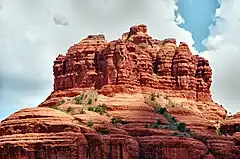Schnebly Hill Formation
The Schnebly Hill Formation is a section of red bed deposits found at the Colorado Plateau, near Sedona, Arizona. It is a dark red sandstone, from 800 feet (240 m) to 1,000 feet (300 m) thick. It lies between Coconino Sandstone and the older Hermit Formation.[1] It is near the Supai Group.[2]
| Schnebly Hill Formation | |
|---|---|
| Stratigraphic range: 290 to 248 million years ago | |
 | |
| Thickness | 800 feet (240 m) to 1,000 feet (300 m) |
| Lithology | |
| Primary | Sandstone |
| Location | |
| Region | Colorado Plateau |
| Country | United States |
| Type section | |
| Named for | Sedona Schnebly |
| Location | Arizona |
| Thickness at type section | 800 feet (240 m) to 1,000 feet (300 m) |
The source of the name "Schnebly" is Sedona Schnebly, after whom the city of Sedona, Arizona, was named.[3]
Geology
The formation traces to the Permian Age.[4][5]
The formation is the most prominent layer of the red rocks of the Sedona area due the presence of hematite – iron-oxide, frankly, rust – giving the sandstone a red color. The Schnebly Hill Sandstone formation comprises three sections:
- the Bell Rock member,
- the Fort Apache member, and
- the Sycamore Pass member.[6]
See also
Sedona-area rocks
Local geology
References
- Cook, Terri (November 20, 2015). "Travels in Geology: Sedona: A journey to the edge of a supercontinent".
- Blakey, Ronald C. "Central Arizona" (PDF).
- "History of Sedona".
- Waverly, Lowell (January 9, 2017). "Chapel in the Rocks". Retrieved 2022-03-07.
- Bills, Donald J. "USGS Scientific Investigations Report 2005-5222, plate 1" (PDF).
- Voges, Brianna. "Sedona Red Rock Formation".
External links and references
This article is issued from Wikipedia. The text is licensed under Creative Commons - Attribution - Sharealike. Additional terms may apply for the media files.